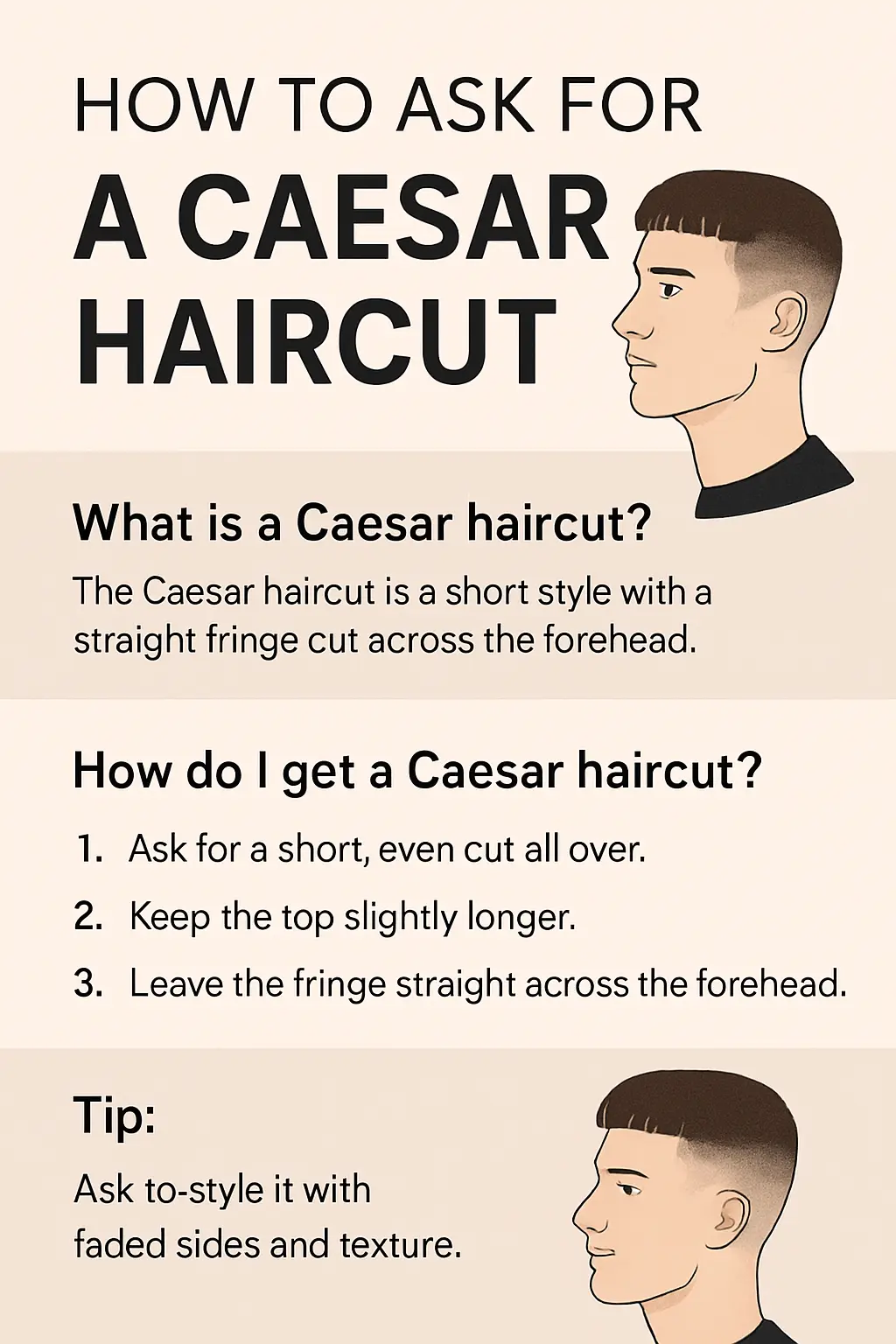Haircuts can feel confusing. You walk into the barbershop, sit down, and suddenly the barber asks, “So, what are we doing today?” If you don’t know the right words, you may end up with something very different from what you imagined. That’s why it’s smart to learn how to describe a style before you get in the chair.
One haircut that has stood the test of time is the Caesar haircut. From Roman emperors to Hollywood actors, this style has a long history and is still popular today. But many people wonder: How do I ask for a Caesar haircut without sounding silly? Don’t worry—I’ll guide you step by step, share my own experiences, and explain how to make sure you leave the barbershop looking sharp.
Why Do They Call It a Caesar Haircut?

The Caesar haircut gets its name from Julius Caesar, the famous Roman general and emperor. If you’ve seen old statues or drawings of him, you’ll notice his hair is short, straight, and combed forward with small bangs across the forehead. That’s the classic Caesar cut.
It’s a style that’s been around for more than 2,000 years. Of course, barbers today give it a modern twist. You might see it with fades on the sides, a bit more texture on top, or even blended with other trendy cuts. But the main feature is always the same: short hair brushed forward with a small fringe (bangs).
Personally, I first noticed the Caesar cut when watching George Clooney in movies. He made it look neat, stylish, and easy to maintain. Later, I realized other celebrities like Drake and Gerard Butler have also worn variations of the cut. That’s when I tried it for myself.
What Is a Caesar Cut?
A Caesar cut is a short, low-maintenance haircut with these main features:
-
Top: Usually 1–2 inches long, cut evenly across.
-
Front: Hair brushed forward with a short fringe (bangs).
-
Sides and Back: Can be the same length or faded/tapered for a modern touch.
Think of it as a clean, structured haircut that works for almost anyone. It looks especially good if:
-
You want to hide a receding hairline.
-
You like simple styles with minimal styling effort.
-
You prefer a haircut that grows out evenly.
The beauty of the Caesar cut is that it’s classic but flexible. You can keep it neat for a professional look or add texture for a casual vibe.
How to Get the Caesar Haircut
When you’re at the barber’s, the key is clear communication. Don’t just say “Caesar cut” and assume they know what you mean. Styles vary, and every barber might picture something different.
Here’s how to explain it step by step:
-
Start with the top.
Tell your barber you want the top short—about 1–2 inches. You can even say, “I’d like the top kept short and cut evenly, with the hair brushed forward.” -
Talk about the fringe.
Mention that you want a small, straight fringe across the forehead. If you prefer a textured or messy fringe, say so. -
Explain the sides and back.
Decide if you want them the same length as the top (traditional Caesar) or faded/tapered (modern Caesar). For example, “I’d like a low fade on the sides, blended into the top.” -
Show a photo.
This is the most important step. Barbers love visuals. Pull up a picture of Julius Caesar, George Clooney, or any celebrity with the style you like. A photo avoids confusion.
When I first asked for a Caesar cut, I was nervous I’d explain it wrong. So, I simply showed my barber a picture on my phone. He nodded, smiled, and said, “Ah, the Caesar cut—got it.” I walked out feeling confident.
How Do I Ask for a Caesar Cut Without Confusion?
If you want to keep it simple, here’s a script you can use:
-
“I’d like a Caesar haircut. Please keep the top about 1–2 inches, brush it forward with a short fringe, and add a low fade on the sides.”
Or if you prefer the classic look:
-
“Can you give me a classic Caesar cut with the top and sides the same length, brushed forward with a short fringe?”
Remember: the more specific you are, the better the result.
Is the Caesar Haircut Good for Everyone?
The Caesar cut is one of the most versatile styles. It works for:
-
Straight, wavy, and even curly hair.
-
Young men who want a trendy, low-maintenance cut.
-
Older men who want to cover a thinning hairline.
When I tried it, I noticed how much easier mornings became. No need for gels, sprays, or long styling sessions. Just a quick brush forward, and I was ready to go.
Why I Personally Like the Caesar Cut
I’ll be honest—I’ve tried a lot of haircuts over the years. Some looked great in the mirror but were a pain to style. Others grew out unevenly and needed frequent fixes.
The Caesar cut felt different. It gave me:
-
Confidence: It’s sharp and neat, which made me feel put together.
-
Simplicity: Easy to style in seconds.
-
Flexibility: I could wear it neat for work or mess it up for a casual weekend look.
And the best part? Friends noticed the change. One even said, “That cut really suits you—it’s simple but stylish.”
Modern Variations of the Caesar Haircut
While the classic Caesar is timeless, modern barbers often add twists:
-
Textured Caesar: Adds layers and choppiness for a messy look.
-
Skin Fade Caesar: Very short sides faded to the skin for a sharp style.
-
Curly Caesar: Perfect for men with natural curls, trimmed short but forward.
-
Blunt Caesar: Fringe is cut straight and blunt across the forehead.
If you’re unsure which version suits you, ask your barber, “Which Caesar variation do you think works best for my hair type?”
What I Wish I Knew Before Asking for a Caesar Cut
Looking back, here are some tips I wish I had known earlier:
-
Maintenance matters.
Caesar cuts look best when trimmed every 3–4 weeks. If you wait longer, the fringe may get too long and lose its shape. -
Face shape plays a role.
It works best for oval and square faces. If you have a round face, ask your barber to add texture on top for balance. -
Styling is optional.
Most of the time, you don’t need products. But if you want a defined look, a little matte clay helps. -
Photos are lifesavers.
Even if you explain it well, barbers may picture it differently. Always bring a photo.
FAQs About the Caesar Haircut
Why do they call it a Caesar haircut?
It’s named after Julius Caesar, who wore his hair short, brushed forward, with bangs.
How to get the Caesar haircut?
Ask your barber for short, even hair on top (1–2 inches), brushed forward with a fringe, and decide if you want the sides faded or the same length.
How do I ask for a Caesar cut?
Be specific: “I’d like a Caesar cut with a short fringe, brushed forward, and a low fade on the sides.” Or show a photo.
What is a Caesar cut?
A timeless haircut where the hair is cut short, brushed forward, and styled with a small fringe across the forehead.
How the Caesar Cut Fits Into Modern Style
The funny thing about haircuts is that they come and go, just like fashion trends. One decade it’s all about long hair, the next it’s about fades, and suddenly mullets are back (yes, somehow). But the Caesar cut never really disappears. It just quietly stays in the background, waiting for people to rediscover it.
I think part of the reason is that it’s practical. Not everyone has the time or patience for complicated hairstyles. A Caesar gives you a clean, professional look without demanding much from you. That’s why you’ll often see it in two groups of people:
-
Busy professionals who don’t want to fuss over their hair every morning.
-
Younger guys who want something cool and trendy without being high-maintenance.
And let’s be honest—haircuts that save time are always winners. I remember when I had a longer hairstyle that required blow-drying, combing, and adding products. It looked fine, but it ate up 20 minutes of my morning. With the Caesar, I’m ready in under two minutes. That difference may not sound huge, but when you’re running late for work, it feels life-saving.
How the Caesar Cut Compares to Other Styles
To really understand why people love the Caesar cut, let’s compare it with a few other popular hairstyles:
-
Crew Cut vs. Caesar Cut
-
Both are short and neat, but the crew cut usually goes upward and back, while the Caesar goes forward with a fringe.
-
Crew cuts are sportier; Caesar cuts are sharper and more stylish.
-
-
French Crop vs. Caesar Cut
-
These two are very close cousins. In fact, a lot of people confuse them.
-
The French crop often has more texture and a longer fringe, while the Caesar is usually more even and shorter.
-
-
Buzz Cut vs. Caesar Cut
-
Buzz cuts are extremely short and uniform all over.
-
A Caesar gives you just enough length to style, while still being low-maintenance.
-
Personally, I feel the Caesar sits nicely between these styles. It gives you some room for expression without making you look like you spent hours in front of a mirror.
Mistakes to Avoid When Asking for a Caesar Haircut
Here’s where I’ll save you from the same mistakes I made early on. If you don’t want to walk out of the barbershop with a cut that doesn’t feel like “you,” avoid these common errors:
-
Not being clear about the fringe
Some barbers will leave it too long, while others may cut it too short. Always explain how much fringe you want. -
Forgetting to talk about fades
If you don’t mention the sides, you may end up with a classic all-around cut when you wanted a modern faded version. -
Assuming all barbers know the term “Caesar”
Believe it or not, not every barber is familiar with the name. That’s why a photo is your best friend. -
Not considering your hair texture
Straight hair works easily, but curly or wavy hair may need a slightly different approach. Always ask your barber how the Caesar cut can be adjusted for your hair type.
My Friend’s Caesar Cut Experience
One of my closest friends, Ramesh, decided to try a Caesar cut after seeing me with mine. At first, he wasn’t sure—it was a big change from his usual side-part style. But after his first cut, he called me and said, “This is the easiest haircut I’ve ever had. Why didn’t I try this sooner?”
He noticed something interesting: his thinning hairline, which used to bother him, looked less noticeable with the fringe. He actually looked younger. That’s one of the underrated benefits of this cut—it camouflages receding hairlines in a way that feels natural.
Tips to Maintain a Caesar Haircut at Home
Once you get the haircut, you’ll want to keep it looking sharp. Luckily, it’s not complicated. Here’s what I do:
-
Trim regularly: Every 3–4 weeks is perfect.
-
Brush forward daily: A quick brush in the morning keeps the fringe neat.
-
Use light products: If you want texture, use a small amount of matte clay or paste.
-
Wash less, condition more: Washing too often can dry out hair. Conditioning keeps it healthy and soft.
I actually found that with this haircut, I don’t need to rely on hair products much. That was a relief, since I used to spend a lot on gels and sprays.
The Caesar Cut and Confidence
Here’s something people don’t talk about enough: haircuts affect confidence. The first time I walked out with a Caesar cut, I felt sharper and more polished than I had in years. It wasn’t just about looking good—it was about feeling put together.
Even simple things, like attending meetings or meeting new people, felt easier. I didn’t worry about whether my hair looked messy or out of place. I already knew it looked fine. That peace of mind is worth more than we realize.
Should You Try the Caesar Haircut?
At this point, you may be asking yourself, “Is this haircut really for me?” Let’s break it down:
-
If you want something simple → Yes.
-
If you’re tired of high-maintenance styles → Yes.
-
If you want to hide a receding hairline → Definitely yes.
-
If you love long, flowing styles → Probably not.
The only way to truly know is to try it once. Hair grows back, so there’s no real risk. You might discover your new favorite style.
Final Thoughts (Extended)
A Caesar haircut isn’t just a throwback to ancient Rome—it’s a timeless choice that continues to adapt to modern trends. Whether you like it classic or updated with fades and texture, it’s a haircut that’s easy to ask for, simple to maintain, and surprisingly stylish.
The key is confidence in the chair. Walk into the barbershop knowing what you want, explain it clearly, and don’t hesitate to pull up a photo. Your barber will appreciate the clarity, and you’ll appreciate the result.
So next time you’re ready for a trim, try saying the words: “I’d like a Caesar cut, please.” You might just discover that sometimes the oldest styles are still the best.




